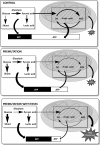Warburg effect linked to cognitive-executive deficits in FMR1 premutation
- PMID: 27335370
- PMCID: PMC5024697
- DOI: 10.1096/fj.201600315R
Warburg effect linked to cognitive-executive deficits in FMR1 premutation
Abstract
A 55-200 CGG repeat expansion in the 5'-UTR of the fragile X mental retardation 1 (FMR1) gene is known as a premutation. Some carriers are affected by the neurodegenerative disorder fragile X-associated tremor/ataxia syndrome (FXTAS), primary ovarian insufficiency, and neurobehavioral impairments. Based on the mitochondrial dysfunction observed in fibroblasts and brain samples from carriers, as well as in neurons and brains from a mouse model of the premutation, we evaluated the presence of the Warburg effect in peripheral blood mononuclear cells (PBMCs) from 30 premutation carriers with either a rebalance of the metabolism [increasing glycolysis while decreasing oxidative phosphorylation (oxphos)] or a metabolic amplification (increasing glycolysis while maintaining/increasing oxphos). Deficits in oxphos-more pronounced in FXTAS-affected subjects-were accompanied by a shift toward glycolysis, suggesting increased glycolysis despite aerobic conditions. Differential proteomics extended these findings, unveiling a decreased antioxidant response, translation, and disrupted extracellular matrix and cytoskeleton organization with activation of prosenescence pathways. Lower bioenergetics segregated with increased incidence of low executive function, tremors, below-average IQ, and FXTAS. The combination of functional and proteomic data unveiled new mechanisms related to energy production in the premutation, showing the potential of being applicable to other psychiatric disorders to identify endophenotype-specific responses relevant to neurobiology.-Napoli, E., Song, G., Schneider, A., Hagerman, R., Eldeeb, M. A. A. A., Azarang, A., Tassone, F., Giulivi, C. Warburg effect linked to cognitive-executive deficits in FMR1 premutation.
Keywords: fragile X; mitochondria; neurological disorder; proteomics; triplet nucleotide diseases.
© FASEB.
Figures




Similar articles
-
Altered Bioenergetics in Primary Dermal Fibroblasts from Adult Carriers of the FMR1 Premutation Before the Onset of the Neurodegenerative Disease Fragile X-Associated Tremor/Ataxia Syndrome.Cerebellum. 2016 Oct;15(5):552-64. doi: 10.1007/s12311-016-0779-8. Cerebellum. 2016. PMID: 27089882 Free PMC article.
-
Mapping self-reports of working memory deficits to executive dysfunction in Fragile X Mental Retardation 1 (FMR1) gene premutation carriers asymptomatic for FXTAS.Brain Cogn. 2010 Aug;73(3):236-43. doi: 10.1016/j.bandc.2010.05.008. Epub 2010 Jun 22. Brain Cogn. 2010. PMID: 20573435
-
Penetrance of the fragile X-associated tremor/ataxia syndrome in a premutation carrier population.JAMA. 2004 Jan 28;291(4):460-9. doi: 10.1001/jama.291.4.460. JAMA. 2004. PMID: 14747503
-
Blood expression profiles of fragile X premutation carriers identify candidate genes involved in neurodegenerative and infertility phenotypes.Neurobiol Dis. 2014 May;65:43-54. doi: 10.1016/j.nbd.2013.12.020. Epub 2014 Jan 10. Neurobiol Dis. 2014. PMID: 24418349
-
Fragile X-associated tremor/ataxia syndrome (FXTAS).Ment Retard Dev Disabil Res Rev. 2004;10(1):25-30. doi: 10.1002/mrdd.20005. Ment Retard Dev Disabil Res Rev. 2004. PMID: 14994285 Review.
Cited by
-
Plasma Biomarkers for Monitoring Brain Pathophysiology in FMR1 Premutation Carriers.Front Mol Neurosci. 2016 Aug 12;9:71. doi: 10.3389/fnmol.2016.00071. eCollection 2016. Front Mol Neurosci. 2016. PMID: 27570505 Free PMC article.
-
Cellular Bioenergetics and AMPK and TORC1 Signalling in Blood Lymphoblasts Are Biomarkers of Clinical Status in FMR1 Premutation Carriers.Front Psychiatry. 2021 Nov 22;12:747268. doi: 10.3389/fpsyt.2021.747268. eCollection 2021. Front Psychiatry. 2021. PMID: 34880790 Free PMC article.
-
Calcium dysregulation and Cdk5-ATM pathway involved in a mouse model of fragile X-associated tremor/ataxia syndrome.Hum Mol Genet. 2017 Jul 15;26(14):2649-2666. doi: 10.1093/hmg/ddx148. Hum Mol Genet. 2017. PMID: 28444183 Free PMC article.
-
Brain Atrophy and White Matter Damage Linked to Peripheral Bioenergetic Deficits in the Neurodegenerative Disease FXTAS.Int J Mol Sci. 2021 Aug 25;22(17):9171. doi: 10.3390/ijms22179171. Int J Mol Sci. 2021. PMID: 34502080 Free PMC article.
-
Mitochondrial targeting as a novel therapy for stroke.Brain Circ. 2018 Jul-Sep;4(3):84-94. doi: 10.4103/bc.bc_14_18. Epub 2018 Oct 9. Brain Circ. 2018. PMID: 30450413 Free PMC article. Review.
References
-
- Klingenberg M., Echtay K. S. (2001) Uncoupling proteins: the issues from a biochemist point of view. Biochim. Biophys. Acta 1504, 128–143 - PubMed
-
- Napoli E., Ross-Inta C., Wong S., Omanska-Klusek A., Barrow C., Iwahashi C., Garcia-Arocena D., Sakaguchi D., Berry-Kravis E., Hagerman R., Hagerman P. J., Giulivi C. (2011) Altered zinc transport disrupts mitochondrial protein processing/import in fragile X-associated tremor/ataxia syndrome. Hum. Mol. Genet. 20, 3079–3092 - PMC - PubMed
-
- Chretien D., Rustin P., Bourgeron T., Rötig A., Saudubray J. M., Munnich A. (1994) Reference charts for respiratory chain activities in human tissues. Clin. Chim. Acta 228, 53–70 - PubMed
Publication types
MeSH terms
Substances
Grants and funding
LinkOut - more resources
Full Text Sources
Other Literature Sources
Medical

